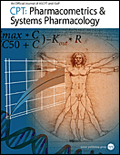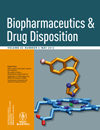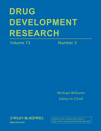
CPT-Pharmacometrics & Systems Pharmacology
Scope & Guideline
Fostering collaboration in the realms of pharmacology and modeling.
Introduction
Aims and Scopes
- Population Pharmacokinetics and Pharmacodynamics:
The journal publishes studies that develop and apply population PK/PD models to optimize drug dosing regimens and evaluate drug efficacy and safety across diverse patient populations. - Physiologically-Based Pharmacokinetic Modeling:
There is a strong emphasis on physiologically-based pharmacokinetic (PBPK) modeling, which allows for the prediction of drug absorption, distribution, metabolism, and excretion based on physiological and biochemical parameters. - Model-Informed Drug Development:
The articles frequently discuss model-informed drug development strategies, highlighting how quantitative models can inform clinical trial designs and dosing decisions. - Systems Pharmacology Approaches:
The integration of systems pharmacology into pharmacometric analyses is a key focus, addressing complex biological interactions and the dynamics of drug effects at the systems level. - Innovative Methodologies:
The journal features innovative methodologies, including machine learning and Bayesian approaches, to enhance pharmacometric analyses and improve predictive accuracy. - Clinical Application and Regulatory Perspectives:
Research published in the journal often includes clinical applications of pharmacometric models, providing insights into regulatory considerations and real-world implications for drug therapies.
Trending and Emerging
- Model-Informed Precision Dosing:
There is a growing emphasis on model-informed precision dosing, which tailors drug dosages based on individual patient characteristics and pharmacokinetic profiles, enhancing therapeutic efficacy and safety. - Integration of Machine Learning:
The application of machine learning techniques in pharmacometrics is on the rise, facilitating the development of predictive models and improving the efficiency of data analysis in drug development. - Pediatric Pharmacokinetics:
Research focusing on pediatric populations, including the development of age-specific pharmacokinetic models, is increasingly prominent, addressing the unique physiological characteristics of children. - Real-World Data Utilization:
The use of real-world data in pharmacometric modeling to inform clinical decision-making and regulatory submissions is becoming more prevalent, reflecting a shift towards more applicable and relevant research. - Systems Pharmacology in Oncology:
Emerging studies are increasingly utilizing systems pharmacology approaches to model complex interactions in cancer therapies, including immunotherapies and combination treatments, to better understand treatment outcomes. - Drug-Drug Interaction Modeling:
There is a heightened focus on modeling drug-drug interactions, particularly using PBPK approaches, to predict safety and efficacy in patients receiving multiple therapies.
Declining or Waning
- Traditional Compartmental Modeling:
While traditional compartmental models have been foundational in pharmacokinetics, there is a noticeable reduction in studies solely relying on these methods without integrating more complex systems or physiologically-based approaches. - Single-Agent Pharmacokinetics:
Research focusing exclusively on the pharmacokinetics of single-agent therapies is becoming less common, as there is a shift towards combination therapies and multi-drug regimens. - Non-Quantitative Studies:
There is a decline in the publication of non-quantitative studies or those lacking robust statistical analysis, as the journal increasingly prioritizes articles with rigorous quantitative methods. - Basic Pharmacokinetic Studies:
Basic studies that do not incorporate advanced modeling techniques or system-level insights are less frequently published, signaling a move towards more integrative and complex analyses.
Similar Journals

Expert Review of Clinical Pharmacology
Pioneering research that shapes the future of clinical pharmacology.Expert Review of Clinical Pharmacology, published by TAYLOR & FRANCIS LTD, is a leading peer-reviewed journal dedicated to the field of clinical pharmacology, with a strong focus on the development and application of pharmacological therapies in patient care. Boasting an impressive impact, the journal ranks in the first quartile across multiple categories including Medicine (miscellaneous), Pharmacology (medical), and Pharmacology, Toxicology and Pharmaceutics (miscellaneous), reflecting its influential position within the scientific community. With a Scopus ranking of #6 in General Pharmacology, Toxicology and Pharmaceutics, the journal also achieves a commendable 93rd percentile, further emphasizing its importance as a resource for researchers and clinicians alike. As it continues to publish innovative reviews and research articles from 2008 until 2024, the Expert Review of Clinical Pharmacology plays an essential role in advancing knowledge, improving clinical practice, and fostering collaboration among experts in pharmacology, thereby driving forward the field's evolution towards better patient outcomes.

AAPS Journal
Transforming Insights into Impactful Pharmaceutical Discoveries.AAPS Journal, published by Springer in the United States, is a leading peer-reviewed journal dedicated to the advancement of research in the field of Pharmaceutical Sciences. With an impressive Q1 rank in its category and a position within the 81st percentile of Scopus rankings, it serves as a vital resource for researchers and professionals seeking to disseminate impactful findings and innovative methodologies. The journal publishes high-quality original research, review articles, and technical reports aimed at addressing the multifaceted challenges in pharmacology, toxicology, and pharmaceutics. Operating under an Open Access model, AAPS Journal ensures broad dissemination of knowledge, contributing to the enhanced visibility and accessibility of research outputs. With a publication window spanning from 1999 to 2024, it continues to shape the future of pharmaceutical research and its applications. Researchers, students, and industry professionals will find a valuable repository of cutting-edge knowledge in this esteemed journal.

JOURNAL OF PHARMACOKINETICS AND PHARMACODYNAMICS
Advancing the Science of Drug InteractionsJOURNAL OF PHARMACOKINETICS AND PHARMACODYNAMICS, published by Springer/Plenum Publishers, stands as a vital resource in the field of pharmacology. With an ISSN of 1567-567X and an E-ISSN of 1573-8744, this journal is well-regarded within the academic community, as reflected in its Q2 ranking in the 2023 Scopus category for Pharmacology. Spanning years from 1996 to 2024, it serves as a comprehensive platform for cutting-edge research on the interactions of drugs within the body, their effects, and the underlying pharmacological mechanisms. The journal provides a critical avenue for dissemination of significant research findings, with a focus on enhancing understanding in pharmacokinetics, pharmacodynamics, and their implications in therapeutic practices. Targeting an audience of researchers, professionals, and students, the journal emphasizes high-quality manuscripts that contribute to the advancement of knowledge in pharmacology. Although currently not an open access journal, it maintains a strong commitment to promoting scientific communication and collaboration.

DARU-Journal of Pharmaceutical Sciences
Fostering open access to transformative pharmaceutical research.DARU-Journal of Pharmaceutical Sciences is a leading peer-reviewed journal published by SPRINGER INT PUBL AG that focuses on the dynamic and rapidly evolving fields of pharmaceutical sciences, including drug discovery, pharmacology, and toxicology. With an impressive Q2 ranking in both Drug Discovery and Miscellaneous Medicine categories for 2023, this journal stands out as a vital resource for researchers, professionals, and students alike, offering a platform for significant contributions to the scientific community. Covering a comprehensive scope from 2000 to 2024 and indexed by Scopus, the journal ranks within the top percentile in its field, with a ranking of #66/313 in Pharmacology and #34/157 in Drug Discovery, reaffirming its impact and relevance. The journal promotes open access to foster widespread dissemination of knowledge in pharmaceutical sciences, ultimately aiming to bridge the gap between research and clinical applications. For those looking to stay at the forefront of pharmaceutical innovation, DARU represents an invaluable connection to the latest studies and breakthrough findings.

DRUGS IN R&D
Shaping the future of pharmacology with impactful insights.DRUGS IN R&D is a premier open access journal dedicated to advancing the field of pharmacology and drug development. Published by Springer International Publishing AG, this journal has been a valuable resource for researchers and professionals since its inception in 1999, contributing critical insights into the pharmacological sciences. With an impressive Impact Factor reflecting its significance, DRUGS IN R&D ranks in the Q2 quartile for Pharmacology, according to 2023 metrics, and ranks #151 out of 313 in the field of pharmacology and toxicology on Scopus. This journal offers an open access format, ensuring high visibility and accessibility of research findings to a global audience, supporting the intrepid pursuit of knowledge in drug research and development. By facilitating comprehensive discussions and innovative research findings, DRUGS IN R&D plays a crucial role in shaping the future landscape of pharmacological studies and advancements.

JOURNAL OF CHEMOTHERAPY
Elevating Standards in Chemotherapy ResearchJournal of Chemotherapy is a distinguished peer-reviewed academic journal published by Taylor & Francis Ltd, focusing on the dynamic fields of infectious diseases, oncology, and pharmacology. With its ISSN 1120-009X and E-ISSN 1973-9478, this journal has been at the forefront of chemotherapy research since its inception in 1989 and continues to play a vital role in advancing medical science through rigorous studies and reviews. It currently holds a respectable position in various Scopus categories, ranked Q3 in several important disciplines, reflecting its commitment to providing quality research. Although it operates under a subscription model, Journal of Chemotherapy remains a crucial resource for practitioners and academics alike, facilitating knowledge exchange and innovation in the treatment of diseases through chemotherapy. With access to the latest findings and therapeutic advancements, this journal is a must-read for researchers, medical professionals, and students seeking to enhance their understanding of emerging trends in chemotherapy.

BIOPHARMACEUTICS & DRUG DISPOSITION
Pioneering Research in Pharmaceutical SciencesBIOPHARMACEUTICS & DRUG DISPOSITION, published by WILEY, is a prominent journal in the fields of biopharmaceutics and pharmacology, dedicated to the dissemination of vital research that spans from the foundational aspects of drug disposition to advanced therapeutic developments. Since its inception in 1979, this journal has established itself as a crucial resource for a diverse audience, including researchers, professionals, and students. With its impact factor indicating solid performance and a current ranking in Q2 for Pharmaceutical Science and Q3 across miscellaneous medicine categories, BIOPHARMACEUTICS & DRUG DISPOSITION serves as a nexus for innovative studies and breakthrough findings. The journal's comprehensive scope ensures that rigorous scientific inquiry is represented, helping to advance the understanding of drug behavior in biological systems. Participating in this scholarly dialogue not only enhances individual knowledge but contributes to the broader pharmaceutical and medical communities, making it an essential publication for all stakeholders interested in drug development and utilization.

DRUG DEVELOPMENT RESEARCH
Driving the evolution of medicine with impactful research.DRUG DEVELOPMENT RESEARCH is a premier interdisciplinary journal published by Wiley, focusing on the latest advancements in drug discovery, pharmacology, and toxicology. With an ISSN of 0272-4391 and an E-ISSN of 1098-2299, this esteemed publication has been a cornerstone in the field since its inception in 1981 and continues to provide cutting-edge research until 2024. Its rigorous peer-review process and strategic placement in Q2 of the Drug Discovery category, as well as ranking #60 out of 157 in Scopus, underscore the journal's relevance and influence, boasting a respectable 62nd percentile ranking. While the journal does not currently offer open access, it remains a vital resource for researchers, professionals, and students seeking to expand their knowledge on the processes of drug development, identifying new therapeutic targets, and assessing the efficacy and safety of novel compounds. Situated in Hoboken, NJ, this journal stands at the forefront of pharmaceutical innovation, making significant contributions to the advancement of medical science.

International Journal of Pharmacology
Championing Knowledge in Pharmacology and PharmaceuticsWelcome to the International Journal of Pharmacology, a key publication in the field of pharmacology, published by ASIAN NETWORK SCIENTIFIC INFORMATION (ANSINET). Since its inception in 2006, this journal has provided a vital platform for researchers and professionals to disseminate their findings and insights in pharmacology, toxicology, and pharmaceutics. Despite recent discontinuation in Scopus coverage, the journal's dedication to fostering scientific dialogue continues to attract contributions from esteemed scholars globally. With an **ISSN of 1811-7775** and **E-ISSN of 1812-5700**, the journal seeks to bridge the gap between laboratory research and clinical application, promoting a deeper understanding of drug actions and interactions. Although it operates under traditional access options, the relevance of its published studies to ongoing pharmacological research remains significant.

Drug Design Development and Therapy
Transforming Pharmaceutical Science with Cutting-Edge InsightsDrug Design Development and Therapy is a premier open-access journal published by DOVE MEDICAL PRESS LTD, dedicated to advancing the fields of drug discovery, pharmaceutical science, and pharmacology. With an impressive Q1 ranking in its categories as of 2023, this journal is recognized for its significant contributions to the understanding of drug design and therapeutic innovations, making it an invaluable resource for researchers, professionals, and students alike. Established in 2007 and committed to open-access since 2008, the journal provides an inclusive platform for disseminating high-quality research from around the globe. With a robust impact factor and remarkable Scopus rankings, including a 24th place in Pharmaceutical Science and a 48th place in Pharmacology, it reflects a strong percentile performance, ensuring that published articles reach and impact a wide audience. By fostering the exchange of cutting-edge information on drug development and delivery systems, Drug Design Development and Therapy continues to play a crucial role in the ongoing battle against disease, promoting innovative approaches to therapeutic solutions and enhancing patient care.